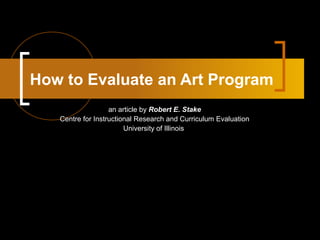
How to evaluate an art program
- 1. How to Evaluate an Art Program an article by Robert E. Stake Centre for Instructional Research and Curriculum Evaluation University of Illinois
- 2. Introduction Other than curriculum, Arts-in-education program are among those evaluated. Different ways will be used to evaluate an educational program. This chapter discussed several approaches to evaluate an art program in further details. Responsive Evaluation Pre-ordinate Evaluation
- 3. Responsive Evaluation Responsive evaluation is an alternative approach that based on what people do naturally to evaluate things: ‘they observe and react’ An educational evaluation is responsive evaluation IF… It orients more directly to program activities than to program intents/objective It responds to audience requirements for information The different value-perspectives present are referred to in reporting the success and failure of the program
- 4. Responsive Evaluation To do a responsive evaluation, the evaluator conceives of a plan of observations. The Evaluation Plan emphasizes on Statement of goals The use of objective tests Standards held by program personnel Research-type reports The help of program evaluators is required to collect the appropriate data. Program evaluators need to conduct personal observation, interviews and others.
- 5. Responsive Evaluation Responsive Evaluation will be useful during formative evaluation when the art education staffs need help in monitoring the program, when one is sure what problem will arise. It is also useful in summative evaluation especially when the audience would like to understand the program activities, its strengths and shortcomings, and when the evaluator feels that is his responsibility to provide vicarious experience.
- 6. Characteristics and Tasks of a Program Evaluator Help to prepare brief narratives, product display, artworks, graphs, etc. Identify the value or important aspects of the programs from the audience/participants Program evaluator gathers expressions of worth from various individuals whose points of view differs Checks on the quality of the report Keeping record of action and reaction of the audience throughout the program Choose the accessible media and approach to ensure that the participants increase the fidelity/trustworthiness of communication
- 7. The Function of Program Evaluation In evaluating an arts-educational program, tests ad other data-gathering devices should not be ruled out. The choice of these instruments in responsive evaluation should be made as a result of observing the program in action, discovering the purpose and interests among groups in the program Meaning that, lecturers/evaluators need to integrate and design test/instruments to gather valid data which will be written in a form of report.
- 8. Prominent events in a responsive evaluation Talk with clients, program staff, audiences Identify program scope Overview program activities Discover purposes, concerns Conceptualize Issues/problems Identify data needs Select, observes, Assemble formal reports If any Format for audience use Winnow, match issues to audiences Prepare case study Observe designated Judge instruments if any outcomes Figure 1
- 9. Implementation Refer to Figure 1 (Clockwise) The evaluator will discuss many things on various occasions with the program staff and representative of audiences. The program scope, activities, purposes and issues will be discussed in a form of displays, photographs or video recorded, curricular content and art products. As described in the clock (Figure 1), the evaluator would pick and choose what to observe, what to record and what to feedback The evaluator somehow should not rely on his/her personal observation. They need to enlist with the students/clients, teachers, community leaders and curriculum specialists. The repeated ness observation from different perspectives and the cross-checking process helps to increase the data reliability.
- 10. Pre-ordinate Evaluation Ralph Tyler, Benjamin S. Bloom and James Popham are foremost among many evaluation writers who have designed coherent evaluation studies around specific objectives their evaluation instruments include, achievement tests, performance tests or observation checklist which have been develop to provide evidence that specific goals were or were not achieved. The Pre-ordinate approach depends on a capability to state the important purposes of education in terms of the student behavior and their ability to accomplish those purposes.
- 11. Pre-ordinate Evaluation Weakness The pre-ordinate evaluation usually is not sensitive to on-going changes in program purpose, not to unique ways in which students benefit from performing in art media or from encountering artistic expression, nor to dissimilar viewpoints that people have as to what is good and bad.
- 12. Pre-ordinate Evaluation Elliot Eisner summarized the weakness of pre-ordinate evaluation in “Emerging Models for Educational Evaluation, 1972” For each learner that are evaluated after the instructional experience such as after a production of artwork, the teacher can reflect upon what has occurred. Therefore, Eisner implies that sometimes it would be preferable to evaluate the quality of the opportunity to learn: the “intrinsic” merit of the experience. (This is because, the pre-ordinate evaluation focuses on reaching the objectives rather than the unexpected findings of the program)
- 13. Conclusion Pre-ordinate evaluation should be preferred to responsive evaluation to ensure that the program objectives have been achieved. With greater focus on the preparation, the pro-ordinate measurements made can be expected to be more reliable. Both responsive and pre-ordinate evaluation can be integrated in arts program. As the program moves in unique and unexpected ways, the evaluation efforts should be adapted to them
- 14. Conclusion The arts-in-education program offer unique experiences to youngsters; its evaluation should reflect the quality of those experiences. A portrayal of program offerings, students involvement and balanced account of perceived strengths and shortcomings should help faculties and citizens find proper place for art in the curriculum.
